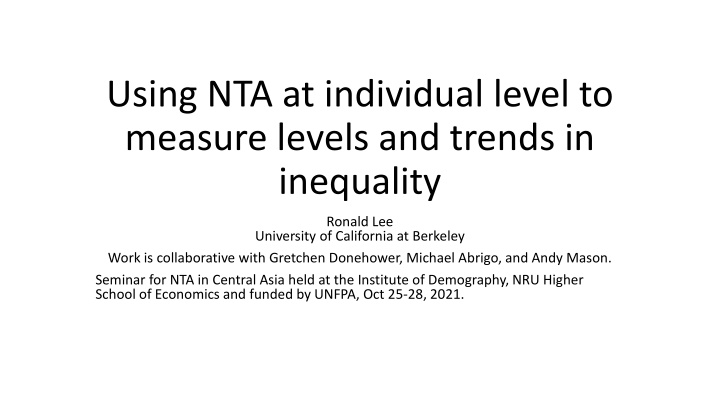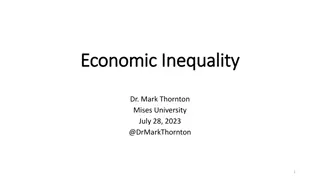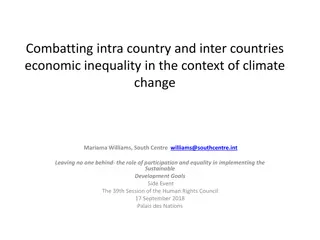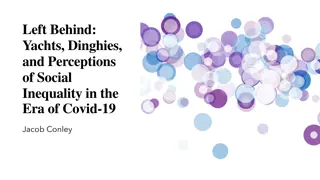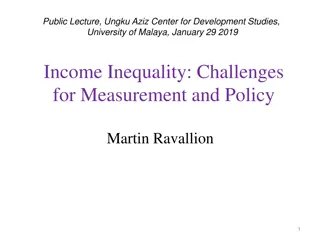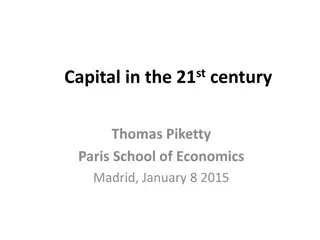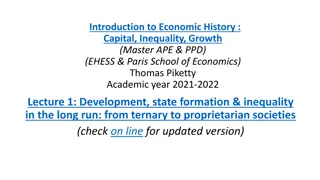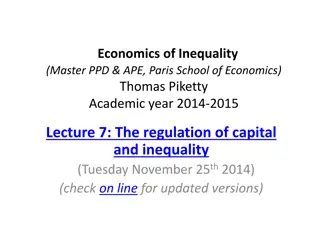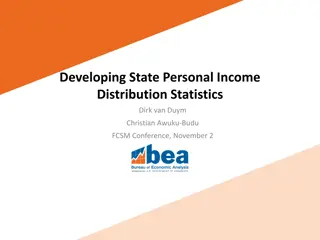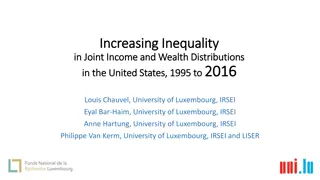Analyzing Inequality Trends Using NTA at Individual Level
NTA (National Transfer Accounts) methodology is utilized to measure levels and trends in inequality at the individual level by adjusting age profiles and estimating adjustment factors. By studying distributions of individual outcomes and exploring factors contributing to inequality, questions like the impact of public transfer programs and trends over time can be addressed.
Download Presentation

Please find below an Image/Link to download the presentation.
The content on the website is provided AS IS for your information and personal use only. It may not be sold, licensed, or shared on other websites without obtaining consent from the author.If you encounter any issues during the download, it is possible that the publisher has removed the file from their server.
You are allowed to download the files provided on this website for personal or commercial use, subject to the condition that they are used lawfully. All files are the property of their respective owners.
The content on the website is provided AS IS for your information and personal use only. It may not be sold, licensed, or shared on other websites without obtaining consent from the author.
E N D
Presentation Transcript
Using NTA at individual level to measure levels and trends in inequality Ronald Lee University of California at Berkeley Work is collaborative with Gretchen Donehower, Michael Abrigo, and Andy Mason. Seminar for NTA in Central Asia held at the Institute of Demography, NRU Higher School of Economics and funded by UNFPA, Oct 25-28, 2021.
This is work in progress. Paper presented at Population Association of America (PAA) meetings in Spring of 2021, available on request. I will give additional results here, mostly preliminary.
Introduction NTA has many uses, for example Economics effects of demographic transition Economic effects of population aging Insights for the economic life cycle National and regional differences in support systems Fiscal impacts of population aging A different use: to analyze inequality. Growing interest in inequality in past decades Recent work has focused on primary income e.g. Distributional National Accounts (Saez and Zucman) and on wealth (Piketty, Saez, Zucman) NTA has a special contribution by including public and private transfers and covering children as well as adults.
Using NTA at individual level Usually, NTA reports age profiles -- averages by age of variables like labor income. But NTA always begins with individual level estimates for each variable These may be systematically misreported so need adjustment. So we form averages to get age profiles and estimate adjustment factors using population data and control totals. We can then go back to the individual data and apply these adjustment factors for each variable. Assuming that all first stage individual data have the same adjustment factor is surely not good, but the best we can do. Now we have individual level NTA micro-files that are consistent with the control totals. These can be used in many ways.
We can study the distributions of individual outcomes Can view these distributions in standard ways, but it is most useful to look at the distributions at each age rather than overall. We can also summarize them in standard ways, for example by the Gini coefficients. Many other measures are available e.g. coefficient of variation of the variable Ratio of e.g. income or consumption for the top category to the bottom category (e.g. top 10% to bottom 10% of income). Now we can ask questions like Does inequality rise or fall with age? What income components are responsible for inequality? Do public transfer programs reduce inequality? If you have NTAs for more than one year you can also ask whether inequality is rising or falling over time.
We can also average the individual NTA for subgroups of the population to get age profiles. By sex/gender By educational attainment of self or household head By educational quantile, e.g. top 20% of individuals by educational attainment, bottom 20% by educational attainment, etc. Many other possibilities. We can observe how these change over time if we have more than one NTA for a population.
Many NTA teams have done important work on this, and also incorporated in NTTA. Hammer, Bernard (2015) National Transfer Accounts by Education: Austria 2010, AGENTA Working Paper 2/2015. Mej a-Guevara, Iv n (2015) Economic inequality and intergenerational transfers: Evidence from Mexico, The Journal of the Economics of Ageing 5: 23 32. Rosero-Bixby, Luis, Ivan Mejia-Guevara Pamela Jimenez-Fontana Liliana Roldan-Molina (2015) SES Inequality In NTAs: Mexico, Costa Rica, and Ecuador, slides presented at National Transfer Accounts meeting, Berkeley, CA, December. Turra, Cassio M. and Bernardo L. Queiroz (2005) Intergenerational transfers and socioeconomic inequality in Brazil: a first look, Taller sobre transformaciones demogr ficas, transferencias intergeneracionales y protecci n social en Am rica Latina, Santiago, Chile, 6-7. Urdinola, B.Piedad, Jorge Tovar (eds.) (2019) Time Use and Transfers in the Americas (Springer) and the chapters in this book. Vanhuysse P, Medgyesi M, G l RI (2021): Welfare states as lifecycle redistribution machines: Decomposing the roles of age and socio-economic status shows that European tax-and-benefit systems primarily redistribute across age groups . PLOS ONE 16(8): e0255760. Many others.
All the analyses I have described so far can be done by anyone that has done NTA for a single year. If you have only done labor income, you can analyze differences according to education, sex, or any other variable.
Can also study intergenerational equity are younger generations treated unfairly? How do age profiles change over time? Rearrange cross-sectional NTAs to get longitudinal histories for birth cohorts. Do more recent cohorts do better than those born earlier? Interesting work by French team using Age-Period-Cohort models. What about the future as the population ages? That requires more complicated approaches to ensure that the net public and private transfer balances are zero each year. That requires assumptions about policy changes in the future higher taxes? Lower benefits? How will bequests received by each child change? Interesting work by UK team, Sefton and McCarthy, using Generational Wealth Accounts, paper forthcoming in Economic Journal. Also see Lee, McCarthy, Sefton, and Sambt (2017) Full Generational Accounts: What do we give to the next generation? Population and Development Review 43(4): 695 720. Mason et al on fiscal projections.
Start by looking at simple distributions by age Why not just dispersion overall? Average labor income, or consumption, or asset income, or public transfer inflows etc. all vary strongly by age. It is good that they vary by age, they should, and we would want them to. If we don t look separately at dispersion by age, then our results will be dominated by these systematic age patterns.
Here is the distribution of labor income of individuals by age in US 2018. Nice, but what does this tell us? How should we think about it? Could compare it to another year. Could express dispersion relative to the mean or median at each age.
Hard to see any change or interesting patterns here. Try some other ways to look at the distributions.
Here is a different look: Labor income distribution in 1992 and 2017 (in constant 2017 dollars). Each box is bounded by 25th and 75th percentiles in age group Means are higher in 2017, but medians are same. Median shown in middle. Whiskers show 5th and 95th percentiles. Age group means are plotted with yellow dots. Is inequality greater only because the mean is higher? Inequality is greater in 2017 with the 95th percentile much higher. Labor inc is much higher at 60-74 in 2017; age at retirement rose.
Here is the interquartile range (75th percentile minus 25th) divided by the median for labor income in 2006 (solid) and 2018 (dashed). Inequality in yl has risen greatly around age 20 *probably 0 s for higher educ students and at older age *probably as some start to retire Median drops to zero here Median is zero here In between ages 30 and 60 *very little difference by age *very little difference 2006 vs 2018.
Consumption: overall distribution in 1992 and 2017 (in constant 2017 dollars) Median consumption increases at every age from 1992 to 2017, but the mean rises much more. Inequality (height of boxes and upper tail) increases a lot with age and time. But relative to medians, inequality is same.
Now look at inequality for social groups, going beyond simple age. US 1988-2018 Male-female, education, and education quintiles. Could do for groups based on any variables in the data, for example rural-urban residence Geographic areas such as provinces, states or districts Ethnic or linguistic groups Always have to use same adjustment factor for all groups unless group- specific control totals are available. May be bad assumption. Could you use income groups to study equity in public transfers? Yes, but problem is income includes public transfers. Care needed. Perhaps define income groups by (labor income plus asset income), and then look at public transfer inflows and outflows.
Start with comparison of average single-year-of-age profiles for males and females in US, 1988 to 2018. How can we summarize inequality by age here? Will have 80+ ratios. I have done simplest possible -- Calculate the ratio of the age profiles of males to females at each age Find the median of these ratios.
Per-capita labor income by sex, 1988 and 2018, relative to av 30-49. Orange bars summarize inequality as median of ratios at each age from 25 to 60 of male labor income to female labor income Male Female Calculate ratio at each age. Bar chart shows median of all these ratios. Inequality lower in 2018.
Total consumption by sex in 1988 and 2018 (relative to labor inc ages 30-49) 1988 Very little inequality in consumption at each age Medians of ratios at all ages. Very little change in median inequality between 1988 and 2018. Note how consumption rises so strongly with age in the US. Much is due to both public and private cost of health care. 2018 Note the scale. Difference from '88 to '18 is very small.
How about wealth holdings, or asset value? We do not have wealth in NTA, at least not yet. NTA is flows. But we have asset income from financial assets, rental value of homes, returns on productive assets etc. If we know the average rate of return on assets (and you can get this as ratio of total asset income to asset value in National Accounts data), you can get an estimate of value of wealth for individuals as the ratio of asset income to average rate of return. For US, average rate of return has been close to .05 for many years, so just multiply asset income by 1/.05 = 20. But no need to do this for measures of inequality, since that is just the same factor for all individuals. Can just look at inequality in asset incomes.
Asset income by sex in 1988 and 2018 (relative to labor inc ages 30-49) Compressed scale, these are .98 vs .96. 1988 Median ratio is not a good measure here, because it is dominated by very low values at younger ages. 2018 Some error in 2018; they are too low. To be corrected! Ratios at age 70 are 3.3 in 1988, and 1.7 in 2018.
Medians of ratios at all ages. Total Public inflows in 1988 and 2018, by sex. Compressed scale. Values are .98 and .97. At median, females receive slightly more than males, but clear that after age 65 males receive a great deal more than females, probably from public pensions.
Now examine differences by education but how measure it? Simplest measure is education of household head (HHH). But over time proportions of the population in educational attainment categories have changed, leading to higher adverse selection into the group with less than secondary education reducing positive selection into the group with more than a BA (college) degree, for example. This makes changes over time difficult to interpret. To reduce problem, we use education household head quintiles These must be calculated separately for each birth cohort of household heads, because older person with just secondary education might be highly educated for the time, whereas now that might be median or lower. So use relative position within the educational distribution of individual s birth cohort.
Labor income by age and education of household head (HHH) relative to labor inc 30-49. By educ of HHH 1988 By educ quintile of HHH, 1988 2018 2018 How to summarize this so we can interpret it more easily?
Labor income by age and education of household head (HHH) relative to labor inc 30-49. By educ of HHH 1988 By educ quintile of HHH, 1988 educ of HHH educ quintile of HHH 3.6 2.6 2018 2018 Inequality measure is median ratio of highest to lowest category. Labor income inequality was much lower in 1988 by educ level but not for quintiles. Most apparent worsening was due to changes in selectivity and in a sense spurious.
Total consumption by education of HHH in 2018 relative to av labor inc ages 30-49 Smaller differences by educ quintile. Strong differences by education of household head.
Consumption by age and education of household head (HHH) relative to labor inc 30-49. By educ quintile of HHH, 1988 By educ of HHH 1988 By educ 1988 By educ quintile 1988 2018 1.8 2018 1988 1988 1.6 1.4 1.3 2018 2018 Considerable inequality by educ level and quintile, but less than I expected. Quintiles have less inequality as expected. Inequality increased by both measures as expected.
Asset income by education of HHH in 2018 relative to av labor inc ages 30-49 By educ 1988 2018 1.8 By educ quintile 1988 2018 1.4 Some error in these; they are too low in 2018. Inequality in asset income rises by both measures but seems much too small. Inequality is always greater for educ level than for quintiles. But ratios at age 70 are 5.0 and 4.5 in 1988, and 7 and 5 in 2018.
Inequality in labor income by age for whole population ages 25-60 by year from 2006 to 2018. Median over ages of ratios. Red lines mark Great Recession, July 2008 to 2011. By sex: ratio of male to female. By education: At least BA to less than secondary degree. Most general: Ratios of interquartile ranges (75% to 25% of distribution). Ratio dropped from 1.93 throughout period, apparently unrelated to recession, ending in 2018 with males still getting 1.67 times more. Advantage of BA+ relative to <HS jumped when recession hit. Stayed high for six years, dropping down in 2015 as labor market tightened and unemployment dropped. Rises rapidly after recession hit in July 2008, continuing until 2011. Then declines very slowly never reaching initial level of equality.
A different look: Educational disparities over time. Comparison of educational disparities in labor income, consumption, and public cash transfers (excluding Social Security old age benefits). Median of ratios of medians across age for BA+/<HS. BA+ labor inc is 3.5 to 4 times as high as < secondary degree. BA+ consumption is only 1.7 times as high as <HS. Same as last slide How do <HS consume so much with such low labor inc? BA+ receive only 25% as great public cash transfers as <HS (excluding public pension) BA+ ratio drops when recession deepens and public transfers increase in 2009.
Total Labor income, 1992 and 2017 (constant 2017 dollars) by education of household head measured in quintiles by birth cohort, with ratios for top to bottom quintile by age. Dispersion rises with age Ratio of 1st to 5th quintile in 1992 and 2017 Similar both dates 75+ is probably meaningless 1992 by educ quintile 2017 by educ quintile 1992 2017
Total consumption, 1992 and 2017 (constant 2017 dollars) by education of household head measured in quintiles by birth cohort, with ratios for top to bottom quintile by age Kink at 15-29 is bigger in 2017. Due to increased higher education. Similar both dates Dispersion lowest for children and elderly 75+ is probably meaningless
Taxes and Social Contributions, 1992 and 2017 (constant 2017 dollars) by education quintiles by age. Taxes include all income, capital, sales and property taxes as well as social contributions like FICA taxes. Ratios are very similar to ratios for labor income. Rich and poor pay similar tax rates. Modest increase in ratios in 2017 is due to increased income inequality, not higher tax rates for rich.
Public Benefits, 1992 and 2017 (constant 2017 dollars) by education quintile with ratios for top to bottom quintile by age. (Benefits include both cash transfers and publicly provided consumption.) Big variation ages 30-59. Hardly any 0-29 and >60. Lower ratio favors lower educ quintile in 2017. Benefits are not well-targeted to lower income groups!
Net Public Benefits (Benefits Less Taxes and Social Contributions), by education quintile, with ratios for top to bottom quintile by age. Positive amount indicates a net receiver of benefits, negative amounts indicate a net payer of taxes. Ages 30-59, lowest quintile at zero net benefits, higher quintiles pay net taxes. All children and elderly receive net benefits. Net benefits are better targeted than inflows. Ignore this one; ratios are meaningless. Lowest quintile Highest quintile
Comparison of Education Quintile ratios for labor income, consumption, and labor income plus net benefits in 1992 and 2017. Labor inc is much more unequal than consumption, and inequality is higher in 2017. Can public transfers account for lower inequality of consumption? YES if we add labor income and net public transfers, ratios are now same as for consumption. Labor Inc + Net Public Trans Labor Inc Consumption
US Total Consumption at ages 0-80, 1985- 2015 (standard mean NTA values)
We can trace out the longitudinal values for those 20 in 1985 (birth cohort of 1965)
Same data rearranged by birth cohorts born 1910 to 2010 (US Total Consumption) NTA estimates for 38 years, 1981-2018 Each birth cohort observed for 38 years or less Cohort born in 1910 is 71 in 1981 and 80 in 1990 Born in 1960 is 21 in 1981 and 58 in 2018. Born in 2010 is 0 in 2010 and 8 in 2018 What do we see here? Each cohort consumes more than the preceding cohorts, when they overlap. So far, younger generations are doing better than their parents.
Same data rearranged by birth cohorts born 1910 to 2010 (US Total Consumption) What do we see here? Pick an age and compare consumption of younger and older birth cohorts on vertical line at that age. Age 35 Younger cohorts always consume more than earlier born cohorts, when they overlap. So far, younger generations are doing better than their parents.
But what will happen in the future for the younger generations with pop aging? Will taxes rise to pay public benefits to the many elderly? Will these generations receive lower benefits when they grow old? This is uncertain. But the claim that younger generations are already being unfairly treated and doing worse than their parents seems to be wrong.
Many possibilities for analyzing trends and levels in inequality, and differences by subgroup. Exploring impacts of public policy. We have just scratched the surface here.
